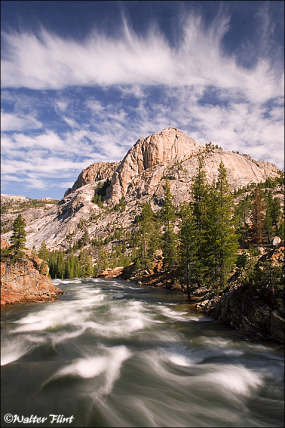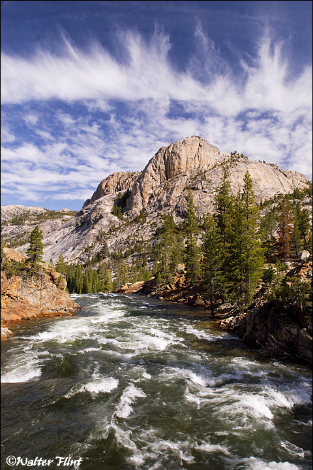Tuolumne River at Glen Aulin and Pluto Dome
click on image for a larger representation
In anticipation of my summer job in Tuolumne Meadows in the sublime and beautiful high country of Yosemite National Park I made a 2000 mile journey across the country to get to the Sierra Nevada Mountains and my home for the next 5 months. Before becoming gainfully employed I had left a cushion of time to allow a foray into the Yosemite wilderness in hopes of jumpstarting a season of calm psyche and meaningful photographs.
Since it was the first week of May the snow up in the mountains above 9000 ft was still copious enough to thwart easy travel even though California was at the beginning of its third year in a row of drought. I decided to follow the Tuolumne River downhill to a place called Glen Aulin and then to follow the river further west and explore some nooks and crannies amongst the polished granite formations and cascading waterfalls of the river.
I spent six days exploring and photographing and the weather was simpatico in its ease and gentleness. The main problem for me was that the weather was too nice and the skies were mostly cloudless the whole time. To compound the issue, there was a constant stream of jet contrails from airplanes flying in and out of San Francisco littering the skies above and obliterating most of my chances of getting a nice landscape that included the sky. I got a few nice images here and there; but nothing that was really exciting me on the inside - nothing that I knew was an image that was stirring both emotionally and visually.
On the sixth and final day I had a long uphill hike back to where I started in Tuolumne Meadows and I was dreading it. I hadn’t gotten a really good photograph and now the trip and opportunity do so was closing quickly. I didn’t really plan on doing much photography on the way out as I just wanted to suffer the 8 mile uphill hike and get home. I got an early alpine start and was hiking by 7am–or-so and the sun was still blocked by the deep walls of the river canyon. It was nice and cool as I started muleaneering my 60 pound backpack onward and upward.
The trail I was on crossed the Tuolumne River at a place named Glen Aulin; a high sierra camp that was not yet opened for the season. The crossing traverses a steel bridge. I had not noticed them before but as I was walking across the bridge I saw that there were glorious, large, wispy, clouds up over the north side of the river canyon. These clouds startled me in that they seemingly showed up instantaneously. I was flabbergasted and couldn’t believe my good fortune as before me lay a most stupendous scene replete with water, trees, rounded granite formations, and clouds, all the while bathed in the most perfect, clean, crisp, morning light.
The clouds were profoundly beautiful and fortuitous I have come across this type of convergence in the past and my usual reaction is to talk - no, goad, cajole, and chastise myself to go faster while ripping the equipment out of my pack to get it it set up before the light changes, clouds go away, Earth opens up and swallows me, etc etc.
I quickly removed my cumbersome backpack and unpacked my tripod, camera body and lenses. I knew right away that I would mostly use my 17-35 zoom lens to include the vital elements in the scene. After a few perfunctory images I began to zero in on what was really spectacular and stirring about this scene.
Compositionally speaking the rule of thirds came into play in both the horizontal and vertical framing. The three components to these images are the river in the foreground-bottom, the trees and granite dome formations in the middle, and the clouds in the upper third.
The first scenes I shot were going to be good indeed and I was happy with what I had shot thus far, but this particular scene had a potential for greatness and I needed to get blissed. I began to think about the clouds and the water as two similar entities instead of two different elements. I began to think of a way to make them mean the same thing, harmoniously; instead of them speaking separately.
The way I chose to achieve harmony between the water and sky was to use a slow shutter speed and get the ripples of the Tuolumne River to become a soft, veil-like gossamer. Considering that the light was concise and bright,I knew I needed to use a neutral density filter to bring my shutter speed down below one second. I had already decided to use a polarizing filter to darken down the sky and give a slightly better separation between it and the clouds. The polarizer also acts in itself as a sort of density filter allowing for slightly longer shutter speeds, but in this case it was not enough for the desired affect I wanted.
I pulled out my X64 neutral density filter which is of a 6-stop density and subtracts 64 times the amount of light hitting the camera sensor than without it. Using this filter accomplished three desirable things for me: first, it allowed me to get the shutter speed down to around two seconds which gave me the affect of representing the water the way I wanted, and the second thing it allowed me to do was select an aperture of f11 which is an aperture where my zoom lens is still critically sharp and gives me all the depth of field I needed in this scene. The third thing was, again, the slow shutter speed that allowed the clouds to flow through the scene a little thereby softening them down slightly to mimic the water of the river.
A challenge of using a X64 neutral density filter is that it so dark that focusing the image is impossible using auto-focus. And, since I was also using a polarizer in conjunction with it I couldn’t even really see the image when I was looking through the viewfinder. I had to pre-focus the scene manually and then attach the filters afterword.
In the days of film this scenario would require extra exposure to compensate for the reciprocity failure of the film and must have been dealt with in metering the scene precisely and then applying the appropriate exposure compensation. Today, the histogram takes care of this for us. Just make an exposure, check the histogram, and then make sure it pushed as far as possible to the right without clipping the highlights. This is perhaps the aspect I miss the most about shooting film: having to meter the scene and place a tonality that will give the best possible exposure based on the given scenario. I always used color transparency film and its rather limited latitude made it an imperative to be skilled in giving it the proper amount of light. I never used auto exposure on my film cameras when shooting nature photographs.
This scene has all the elements of that which I consider a great landscape photographic opportunity; ciello, agua, terra (earth, water, sky) all lit at a most favorable time of day and all coming together at an unexpected way after I had emotionally sort of given up.
Below is the same image shot without the neutral density filter. I think it is also a great representaion of this scene and conveys a slightly different feeling. I leave it up to you the viewer to decide.
Nikon D200 camera at ISO 100
Nikon 17-35 mm f2.8 lens at f11
2 second exposure
Nikon Circular Polarizer
B&W X64 Neutral Density Filter



